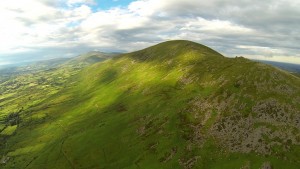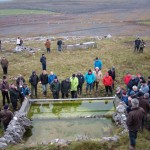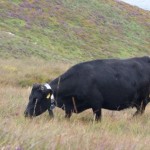The Burren region, located between Counties Clare and Galway, is…
“The mountain didn’t get that way without work“ – Blackstairs Farming Group
Communicating the Blackstairs Farming Groups High Nature Value message to farmers and funders
The Blackstairs Mountains are located in the south east of Ireland. An inland mountain range, they form the boundary between counties Carlow and Wexford. The highest peaks are Mount Leinster (796m), Blackstairs (734m) and Slievebawn (527m). The climate is drier and sunnier than the west of Ireland and so the principal habitat is Dry Heath, though Blanket Bog and Wet Heath occur along with Acid Grassland as vegetation mosaics.
The upper slopes of the mountain range are unenclosed and are farmed as commonage. Typically sheep, mostly Cheviot, are put up between April and June when the lambs are strong enough. They are brought down in autumn and the lambs sold on as store lambs. A small number of farmers graze the commonage year round. This usually depends on how much green lowland fields farmers have to support stock in the winter. A small number of farmers have cows (sucklers) and horses on the commonage but the vast majority use sheep.
The Blackstairs mountain range covers circa 70km2, of which 50.52km2 corresponding to the unenclosed land is designated a Special Area of Conservation. Dry and Wet Heath exist outside the Special Area of Conservation on enclosed land along with good examples of Semi-natural Grassland and Woodland and the area qualifies as being of high nature value due to the presence and quality of its peatland habitats. The mountains also have value as a cultural landscape containing archaeological sites dating back 5000 years including cursus monuments, summit cairns, a portal tomb and a cluster of rock art sites from the Neolithic period. The field systems adjacent to the commonage contain some particularly large granite drystone walls, up to 2.5m high and 4m wide in places and artefacts linked to traditional farming practices.
“You have to be born into hill farming and have a genuine interest in it”
The economic viability of farming in The Blackstairs has been in decline for decades. It became clear that the future of hill farming and hill farming communities was precarious and a small group of people began to ask what could be done. In April 2014, funding for pilot locally led projects using a similar approach to the Burren LIFE project was included in the Irish Rural Development Programme 2014-2020. Contact was made with Dr Brendan Dunford (Burren LIFE) and Dr James Moran (IT Sligo) and on their advice the Blackstairs Farming Group was formed. A diverse group, there were many motivations for involvement, the predominant one being a desire for farming and farming communities in the Blackstairs to move from slow incessant decline to a more sustainable footing. There was also a shared connection to the land, to the Blackstairs and a desire for the skills and knowledge acquired by Blackstairs farmers over generations to be recognised, valued and sustained.

“You don’t learn anything about hill farming in agricultural college”
Over the next year the Group attended events including the Burren Winterage School and the Who Cares for the Uplands conference organised by the Irish Uplands Forum. We learned about HNV Farming, Locally Led Agrienvironment Projects, Ecosystem Services and Public Goods and understood that our farmers produced goods which were valued by society but which could not be sold at the mart. That the farming system in the Blackstairs was responsible for the rich biodiversity and beauty of our landscape, providing high quality water supplies to surrounding towns and villages and storing carbon in upland peats. During this period we encountered The European Forum on Nature Conservation and Pastoralism. In March 2015 the European Forum on Nature Conservation and Pastoralism employed Colin Gallagher as the Forums High Nature Value Ireland Officer and offered technical support to our group to help us develop a locally led project. We were delighted but there was an obstacle. We needed to raise funds to assemble the baseline environmental data required.
The composition of our committee was crucial in getting the funding we needed. It contained farmers, both lowland and hill farmers; a local architect who could place funding applications in policy context and who had knowledge of and confidence in community led design processes; two local councillors (elected representatives to local government) who were able to guide us through local administration and direct our funding request to decision makers, and a retired environmental science lecturer with experience and contacts in the field of environmental management.
In June 2015 the Blackstairs Farming Group secured the funding required from sources including The Heritage Council and Carlow and Wexford Local Authorities. We then began to plan how to develop from being a small working group to a more representative group spanning two counties. Positive engagement betweenthe Blackstairs Farming Group committee, the project team and the local farming community was prioritised and included in the brief for the selection of the ecology team. The European Forum on Nature Conservation and Pastoralism also recognised that communication and engagement were important, and funded the role of a local coordinator to liaise with farmers, stakeholders and funding bodies and to manage the project locally. The project team were in place by mid-June 2015 and comprised Colin Gallagher (European Forum on Nature Conservation and Pastoralism High Nature Value Ireland Officer), Dr Mary Tubridy (Ecology Team) and Helena Fitzgerald (Local Coordinator and Blackstairs Farming Group Committee Member).
The first project team meeting developed the methodology for the research phase of the project and included a plan for community engagement. This plan was then discussed and agreed by the Blackstairs Farming Group Committee. The research work involved gathering information on farming practices and changes to farming in the Blackstairs through face to face interview with and completion of a questionnaire by Blackstairs hill farmers. The habitat mapping involved field work to establish the extent and condition of habitats within the study area and included a series of farm walks around the mountain range attended by hill farmers and other stakeholders.
The Blackstairs Farming Group committee contributed to the project planning phase, suggesting who the project team could make contact with and advising on practical issues like suitable access routes to the mountain. In addition the Blackstairs Farming Group agreed a communications plan which included placing regular project updates on social media (@BlackstairsFarm on Twitter and Blackstairs Farming Group on Facebook) and in local print media such as parish newsletters and newspapers. There was still concern that isolated farmers would not hear about the project, so the project coordinator and Blackstairs Farming Group Committee Members contacted many farmers by phone and text message to share information on the project and to encourage attendance at meetings and events. In some cases communication by land line was the only way of making contact with these farmers. In addition the project coordinator identified and contacted other stakeholders including Teagasc, Coillte and the National Parks and Wildlife Service. A particular challenge at this stage of the project was the absence of specific detail on what the project would mean for farmers. It was explained that the process was farmer-led and would reflect the issues farmers themselves identified as being important, however this approach was not a familiar one and for a period there were concerns that the project had an extremist environmental agenda to remove farmers from the mountain and re-wild. The work of Colin Gallagher was particularly skilful in making it clear that the project had a farming focus and in time concerns abated. A turning point came when hill farmers themselves explained to the concerned farmers that the wildlife and habitats on the hill were there because the hill was farmed, and that the project was working to identify how hill farming could be supported and optimised for the environment and for the farmer.
“How can hill farming become more attractive for the young farmer?”
By September 2015 the information gathering phase of the project was complete and it was decided to hold an information meeting to present the research findings to Blackstairs farmers. At the meeting held in Rathanna on the 9th October and attended by circa 70 hill farmers and other stakeholders, it was unanimously agreed to proceed to the next stage of development of the locally led project. Colin Gallagher presented his analysis of data from the Irish Central Statistics Office which indicated a 50% drop since 1991 in the number of farms in the Blackstairs where the main holder was under 44, with a 50% reduction in sheep numbers over the same period. At the meeting representative farmers from around the mountain joined the Blackstairs Farming Group committee to participate in a series of workshops to further develop the project.
“I would love to be farming full time or even to make it profitable enough to hand on to the next generation”
The project report “A Case For a Locally Led Agri Environment Scheme For The Blackstairs, Preliminary Proposal” will be ready in early 2016. This report will shape our submission to Irelands Department of Agriculture Food and the Marine for Rural Development Programme 2014-2020 funding under the locally led measure. The engagement with Blackstairs farmers over the last 9 months, involving over 800 hours of voluntary input by Blackstairs hill farmers has indicated that in addition to the locally led project there is interest in developing other business areas to support the hill farming enterprise, including potentially forming a lamb producer group, developing sustainable tourism products and farm based businesses associated with the management of the mountain. It has also become clear that Blackstairs farmers who have come to project meetings to listen, learn and contribute are keen to innovate and are outward looking; characteristics hill farmers are not usually credited with. The legacy of our project with the European Forum on Nature Conservation and Pastoralism is a sense of momentum which we would like to build on as we work towards more sustainable and resilient farming communities in the Blackstairs. Given the rate of decline and the age profile of our farmers, the question is; are we too late?
Article by Helena Fitzgerald, Blackstairs Farming Group Coordinator
Twitter: @BlackstairsFarm
Facebook: www.facebook.com/blackstairsfarming/







